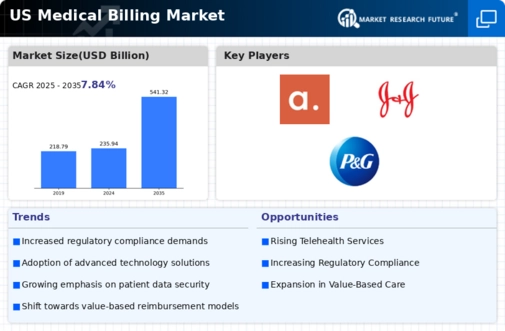Rising Healthcare Expenditure
The medical billing market is experiencing growth driven by the increasing healthcare expenditure in the United States. As healthcare costs continue to rise, patients and providers alike are seeking efficient billing solutions to manage expenses. In 2023, healthcare spending in the US reached approximately $4.3 trillion, accounting for nearly 18% of the GDP. This trend indicates a growing demand for streamlined billing processes, as healthcare providers aim to optimize revenue cycles and reduce administrative burdens. The medical billing market is likely to benefit from this heightened focus on cost management, as organizations invest in advanced billing technologies and services to enhance operational efficiency. Furthermore, the shift towards value-based care models necessitates accurate billing practices, further propelling the demand for sophisticated medical billing solutions.
Shift Towards Value-Based Care
The medical billing market is being shaped by the ongoing shift towards value-based care in the US healthcare system. This model emphasizes patient outcomes and cost-effectiveness, which necessitates accurate and transparent billing practices. As healthcare providers transition from fee-for-service to value-based reimbursement models, the complexity of billing increases, requiring advanced solutions to manage these changes. The medical billing market is likely to see a surge in demand for services that can handle the intricacies of value-based care, including performance metrics and outcome tracking. This shift not only impacts billing processes but also encourages providers to invest in technology that supports data analytics and reporting. Consequently, the medical billing market is expected to evolve, adapting to the needs of a value-driven healthcare landscape.
Regulatory Changes and Compliance Needs
The medical billing market is significantly influenced by ongoing regulatory changes and the need for compliance within the healthcare sector. As new regulations are introduced, healthcare providers must adapt their billing practices to ensure adherence, which can be a complex and resource-intensive process. The medical billing market is likely to see increased demand for compliance-focused billing solutions that can help organizations navigate these challenges. For instance, the implementation of the No Surprises Act aims to protect patients from unexpected medical bills, necessitating changes in billing practices. This regulatory landscape compels healthcare providers to invest in training and technology that support compliance, thereby driving growth in the medical billing market. As regulations continue to evolve, the need for adaptable and compliant billing solutions will remain a critical driver for the industry.
Growing Demand for Outsourced Billing Services
The trend of outsourcing billing services is gaining traction within the medical billing market. Healthcare providers are increasingly recognizing the benefits of outsourcing to specialized billing companies, which can enhance efficiency and reduce operational costs. In 2023, it was estimated that around 30% of healthcare organizations in the US opted for outsourced billing solutions, reflecting a growing trend towards this model. The medical billing market is likely to expand as more providers seek to focus on core clinical functions while delegating billing tasks to experts. Outsourcing not only alleviates administrative burdens but also allows for access to advanced billing technologies and expertise that may not be available in-house. This trend suggests a potential shift in how billing services are delivered, with a growing emphasis on partnerships between healthcare providers and billing service companies.
Increased Adoption of Electronic Health Records (EHR)
The transition to electronic health records (EHR) is significantly influencing the medical billing market. As healthcare providers increasingly adopt EHR systems, the integration of billing processes becomes more streamlined and efficient. According to recent data, approximately 85% of office-based physicians in the US have adopted EHR systems, which facilitates better data management and reduces billing errors. This trend suggests that the medical billing market is poised for growth, as EHR systems often come equipped with billing functionalities that enhance accuracy and speed. Moreover, the interoperability of EHR systems with billing software allows for seamless data exchange, which is crucial for timely reimbursements. As healthcare organizations continue to prioritize digital transformation, the demand for integrated billing solutions is expected to rise, further driving the medical billing market.














Leave a Comment